Fascism was defeated in the Second World War. The alliance between Nazi Germany, fascist Italy and Japan was beaten, and the fascist regimes dismantled. Hitler committed suicide, Mussolini was strung up by his own people, and the Japanese government dissolved itself. Fascism, rising during the first half of the 20th century, collapsed before it could see the second half.
However, the collapse of fascism did not mean that as a problem it had been wiped off the face of the earth. After the Second World War, and in the Third World, fascism actually increased. The dictators and juntas which came to power in Latin America and Africa were also basically committed to fascism.
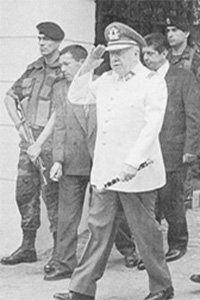 |
Third World fascists did not hesitate to commit atrocities recalling the Nazi massacres. For instance, the Chilean dictator General Pinochet, who came to power with a military coup against President Allende in 1973, turned his country into a river of blood. Pinochet had Allende killed with tank and jet attacks on the Presidential Palace. However, the Chilean people were told that Allende had committed suicide because he refused to surrender. Following that, a ruthless policy to eliminate Allende's supporters and the opposition was implemented. The junta killed thousands of people in its first year in power, and approximately 90,000 Chileans out of a population of 9 million were arrested. The terrorizing of the population, corpses piled up in morgues, or shot and thrown into the Mapocho River, the detention of suspects in the Santiago Stadium, hostage-takings, frequent search operations and lootings, were just a few of the crimes of the Pinochet regime. Academic institutions were "cleansed," and history and geography courses in universities were subjected to censorship by the fascist authorities.
Fascist dictatorships similar to that of Pinochet came to power in Latin American countries such as Argentina, Guatemala, El Salvador, Nicaragua, Honduras and Paraguay, and also carried out appalling cruelties. Thousands of opponents of the junta in Argentina "disappeared." According to the evidence that emerged after the fact, more than 2,000 political detainees were put onto planes and thrown out over the sea from thousands of feet in the air. A former gendarme, Federico Talavera, who appeared on Argentine television on April 27, 1995, admitted the tortures carried out during the time, saying among other things that pregnant women were thrown into the sea and that dogs were specially trained to bite peoples' sexual organs. According to his confession, the dogs would take political detainees' sexual organs in their mouths and wait for an order. If the detainee refused to talk, then the dog was told to bite.
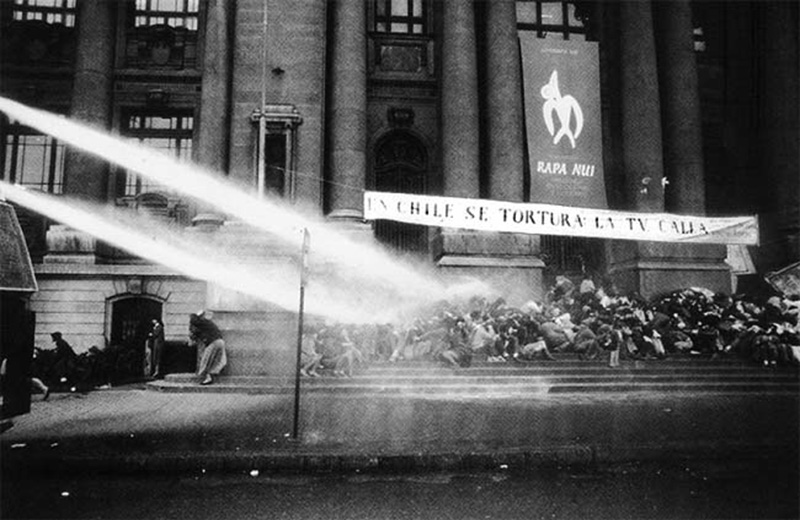 |
| On April 27, 1995, a former gendarme confessed to the torture carried out during the junta regime. The people then poured onto the streets to protest against Pinochet. |
The brutality in Guatemala was also horrifying. In the 1960s and 1970s, the fascist regime which overthrew the country's first and only elected president, Jacobo Arbenz, in 1954, turned the country into killing-fields. Among the fascists' targets, in conformity with fascism's general hatred of religion, were men of religion. Amnesty International announced that between October 1966 and March 1968, some 8,000 Guatemalans, including many priests, were killed by "death squads." In 1972, the number of death squad victims went up to 12,000, and to 20,000 four years later.
The Roman Catholic Bishops Conference described the government's policy as "genocide." In Killing Hope:US Military and CIA Interventions Since World War II, the American writer William Blum explained the torture methods used by the Guatemala regime:
Anyone attempting to organize a union or other undertaking to improve the lot of the peasants, or simply suspected of being in support of the guerrillas, was subject ... unknown armed men broke into their homes and dragged them away to unknown places ... their tortured or mutilated or burned bodies found buried in a mass grave, or floating in plastic bags in a lake or river, or lying beside the road, hands tied behind the back ... bodies dropped into the Pacific from airplanes. In the Gual area, it was said, no one fished any more; too many corpses were caught in the nets ... decapitated corpses, or castrated, or pins stuck in the eyes ... a village rounded up, suspected of supplying the guerrillas with men or food or information, all adult males taken away in front of their families, never to be seen again ... or everyone massacred, the village bulldozed over to cover the traces ... seldom were the victims actual members of a guerrilla band. One method of torture consisted of putting a hood filled with insecticide over the head of the victim; there was also electric shock — to the genital area is the most effective.133
The Brutal Dictator Pinochet |
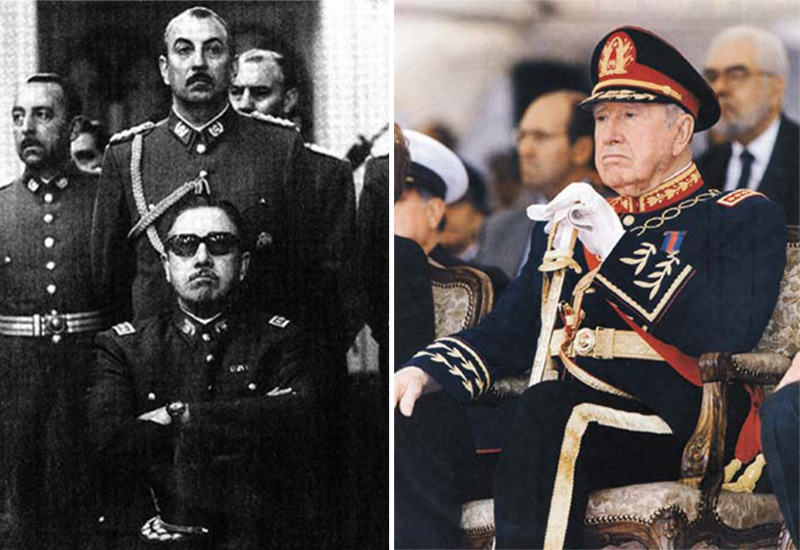 |
| Pinochet's Rivers of Blood: |
| Pinochet brought only blood and death to Chile. His regime will be remembered in history for its torture, killings, and "the disappeared." Left. Pinochet at a press conference after his 1973 coup. Right. The Chilean dictator shortly before relinquishing power. |
William Blum quotes a statement by a female native Guatemalan. Taken for questioning, along with her family, on charges of being an "opponent of the regime," Rigoberta Menchú Tum described what happened to her on December 9, 1979:
On 9 December 1979, my 16-year-old brother Patrocino was captured and tortured for several days and then taken with twenty other young men to the square in Chajul ... An officer of [President] Lucas Garcia's army of murderers ordered the prisoners to be paraded in a line.... I was with my mother, and we saw Patrocino; he had had his tongue cut out and his toes cut off. The officer jackal made a speech. Every time he paused the soldiers beat the Indian prisoners. When he finished his ranting, the bodies of my brother and the other prisoners were swollen, bloody, unrecognizable. It was monstrous, but they were still alive. They were thrown on the ground and drenched with gasoline. The soldiers set fire to the wretched bodies with torches and the captain laughed like a hyena and forced the inhabitants of Chajul to watch.134
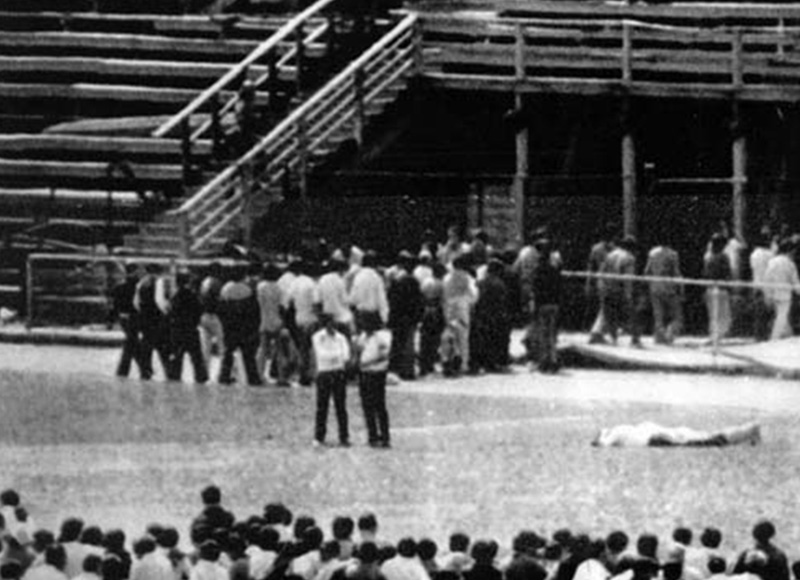 |
| In 1984, 3,000 "suspects" were locked in the Santiago Stadium for interrogation. In the first years of the regime, thousands of people were killed, and 90,000 people out Chile's population of 9 million were detained, many of whom were tortured. Such was the manner in which Pinochet introduced fascism to the people of Chile. |
These are but a few examples. The fascist regime in Guatemala, run first by General Romeo Lucas Garcia, and then by General Efrain Rios Montt, by similar methods, killed more than 100,000 people. William Blum speaks of victims "having their eyes put out, their testicles cut off and stuffed in their mouths, and their hands and feet cut off" by the security forces, as well as women "having their breasts cut off."
South African Fascism |
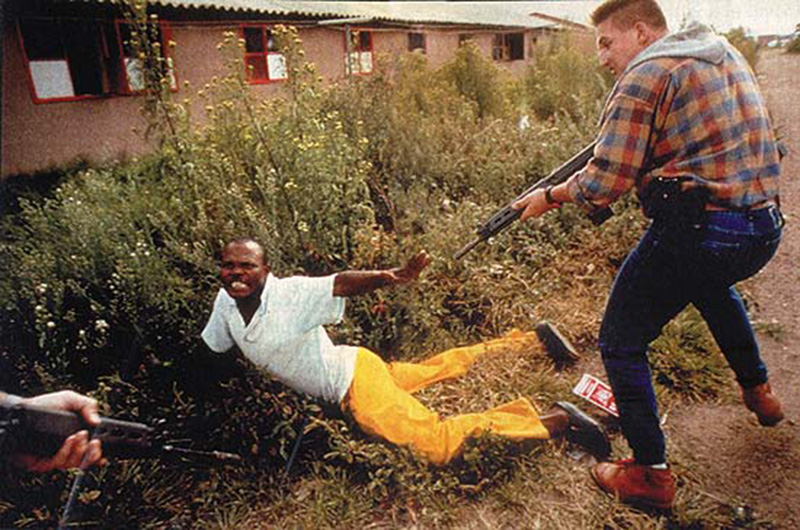 |
| The "apartheid" regime in South Africa followed a racist policy as harsh as that found in Nazi Germany. The native black population, which made up the majority, was oppressed and brutalized for years by the white minority. |
Similar fascist regimes held power in African countries, such as Zaire, Uganda and South Africa, for long periods of time. The regime of South Africa adopted a fiercely racist ideology, reminiscent of Nazi Germany. The black majority in South Africa, the original inhabitants of the land, were exploited by the white minority for years.
In short, the second half of the 20th century was as much the brunt of fascist violence as the first. Fascist regimes, similar to those overthrown in Europe, emerged in Latin America and Africa, who again led to the world becoming'a battlefield where "the strong survive and the weak are eliminated."
 |
At this point in time, being the beginning of the 21st century, many of the fascist dictators of the 1960s and 70s have disappeared. However, fascism may rear its head at any time, in various places and under different conditions. The Middle East in particular has suffered from the violence of fascist regimes and organizations. One such fascist dictator is at this very moment threatening the region: Saddam Hussein.
It will be useful to examine Saddam Hussein's past in order to better recognize his fascist character.
The events that brought him to power in Iraq began with a military coup. In February 1963, a group of officers and street militants, calling themselves the Baath (Resurgence) Party, overthrew General Kassem who was then in power. Among these militants was one young member of the six-man team charged with killing Kassem: Saddam Hussein al-Takriti, or Saddam Hussein from Takrit. Although he was not a soldier, Saddam usually wore a military uniform, and after the coup, he was brought in by the Baath administration to head a group responsible for terrorism and murder. The first thing he did was to develop new and effective methods of torture with which to interrogate opponents of the coup. When the administration that followed the Baath's palace coup collapsed, in November of that same year, Saddam's torture facility was exposed, which was equipped with various implements of torture that Saddam had invented himself.
The Baath government lasted less than ten months, and was brought down by another coup. But the party carried out a second coup on July 17, 1968. This time the plotters remained in power.
The leader of this second Baath coup was "torture expert" Saddam Hussein. He brought in his personal relatives into key positions in the regime, and eventually gathered complete power by eliminating his rivals. The merciless torturer had become the dictator of Iraq.
After coming to power, Saddam pursued war and conflict constantly. In 1988 he engaged in a surprise and totally unjustified attack on Iran, occupying part of the country. The war lasted for eight years and cost the lives of hundreds of thousands of Iraqis and Iranians. Two years after the war had ended, he invaded Kuwait, again without justification, leading to the Gulf War. Like Hitler, who carried out savage attacks for four years to enlarge German territory, Saddam terrorized those around him.
 |
| Saddam compares himself to Nebuchadnezar, the pagan ruler from ancient Babylon. (Above. A coin Saddam had minted to that end.) Like all fascists, Saddam is nostalgic for the savagery of ancient paganism. |
Furthermore, he had no qualms about using the most oppressive methods against his own people. Throughout his rule, those regarded as opponents of the regime, and various political and ethnic groups, have suffered all kinds of repression. An edition of Newsweek described Saddam's fascistic character in the following manner:
His detractors call him a bloodthirsty tyrant—the Butcher of Baghdad. Saddam Hussein rules Iraq with an iron hand inside a steel glove, backed by a million-man Army and a legion of informers, assasins and torturers. Saddam, as he is known throughout the Middle East, is utterly ruthless in the pursuit of glory for himself and his country. He has not hesitated to use poison gas on enemies both foreign and domestic.135
Saddam has spilt the blood of numberless Iraqis. At the end of the war against Iran, 1 million out of Iraq's population of 17 million had either been killed or injured. More than 1 million people left the country for political and economic reasons. The human rights organization Middle East Watch states that many people were relocated or deported, arrested and punished for no reason, and that the use of torture was widespread, together with political executions and unsolved killings in Iraq. According to Amnesty International, torture, even of children, includes such methods as roasting victims over flames, amputating noses, limbs, breasts and sexual organs, and hammering nails into bodies.136
Saddam's Massacre at Halabja |
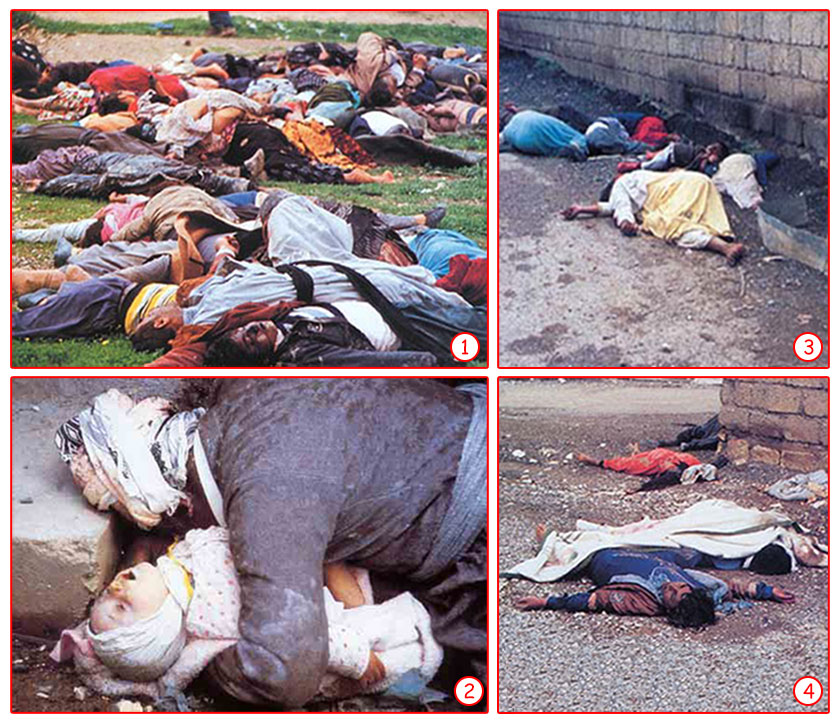 |
| Saddam Hussein attacked the village of Halabja in northern Iraq with chemical weapons in 1988, because it would not submit to his authority. Some 5,000 Kurdish civilians in the village died horribly from the burning effects of these weapons. Dead mothers clutching their babies, the corpses of small children in the middle of the streets, demonstrated that the Iraqi dictator was a cruel fascist sharing the same philosophy as Hitler and Mussolini. |
The atrocities carried out by Saddam at Halabja in 1988 demonstrate his fascistic treatment of people of different ethnic origins. Nerve gas was used against the Kurdish settlers, causing the death of many innocent men and women, including babies and the elderly. Amnesty International reported that 5,000 Kurds were killed in a single Iraqi gas attack on the village of Halabja, and many more thousands perished in similar attacks elsewhere in the country. 137
The torture inflicted on the political opponents of fascist Saddam was still worse. A doctor who fled from Iraq described: "I was an intern in a hospital in the South. Only doctors were allowed to see the people brought from prison. Most of them were no more than lumps of meat, and most of them died. No political detainee lived through the torture. I fled when I realised that I was about to be detained."138
Even Saddam's own family and closest associates were victims of his cruelty. His step-brother Barzan Takriti fled to the United Arab Emirates out of fear that Saddam and his son Uday were going to kill him. Two of Saddam's son-in-laws, Hussein and Saddam Kamel fled to Jordan out of fear of him. Saddam then guaranteed them that their lives would not be in danger, but as soon as the brothers returned to Baghdad, they and their father were killed. Later, their mother's body was found cut to pieces, all which happened before the eyes of the world.
The Iraqi leader also uses cruel methods as well to intimidate opponents who have fled the country. For instance, General Najib Salihi, who escaped to Jordan in 1995, reported that his close family were raped and that tapes of the act were sent to him. He also said that the same has been done to many other opponents of the regime.
As we can see from these numerous examples, Saddam's authority in Iraq is entirely based on intimidation, terror and torture, while the people within his fascist regime are hungry, unemployed and living in poverty. Little children are dying of hunger and lack of medicine, while the rest of the nation is doomed for either death or extinction. Despite all of this, the people will say nothing against Saddam, whether out of fear or from the effects of mass-hypnosis, but instead blame "them," Saddam's enemies, for the poverty they are suffering.
Saddam's Complex |
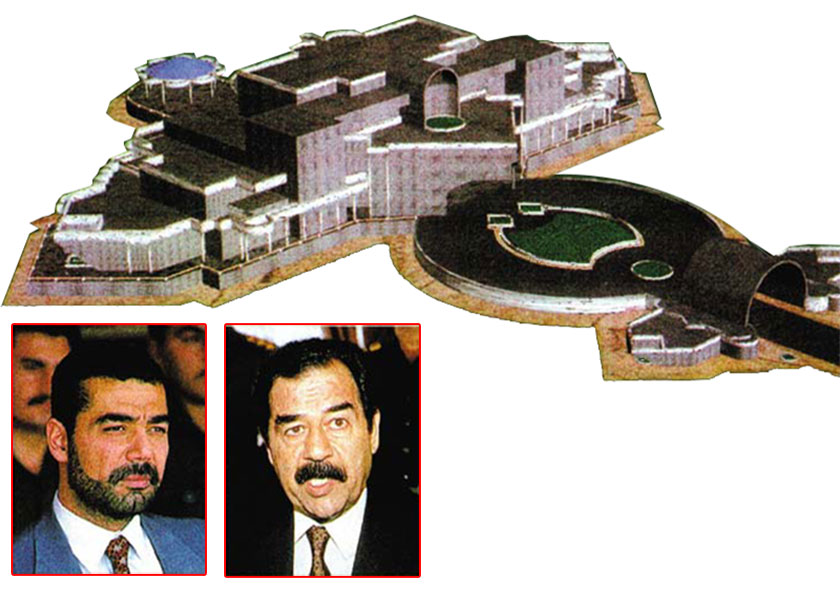 |
| While the people of Iraq are living in poverty and hunger, Saddam lives in great pomp in the 50 palaces he had built.(To the side is a plan of one of these palaces.) Saddam's son Uday shares his father's paranoia. Fascism in Iraq passes from "father to son." |
In Saddam, we can also discern several other fascist characteristics. Of these is the way he compares himself to pagan dictators of the past, just as the Nazis and other fascists had done. The "Sparta" that Saddam selected was Babylon, a pagan empire of the ancient Middle East. He sees and portrays himself as heir to the Babylonian King Nebuchadnezzar, who had "no opponents from horizon to sky."139 In Iraq, ceremonies are held symbolizing the resurrection of the Babylonian Empire, in a manner that recalls the pagan ceremonies of the Nazis. Nebuchadnezzar, who destroyed the temple of Solomon and carried the People of Israel to captivity in Babylon, is known to history for two characteristics, that of a ruthless commander, and a great architect. He was also filled with a pride bordering on the psychopathic. He had his name written on every one of the bricks used in the construction of the buildings he had erected. In direct imitation, and despite all the poverty and misery he inflicts on his people, Saddam has his name written on the bricks used to build the palaces he constructs so ostentatiously.
A great portion of the Iraqi people, however, have been so psychologically deformed by Saddam's fascism, that they do not see the construction of such palaces as a wrong or as an injustice to them. On the contrary, they regard these palaces, where Saddam lives in great luxury, as a matter of national honor, and something Iraq can display proudly to foreigners.
Another example of Saddam's fascist character is that, although he has no religious belief, he sometimes puts on a false facade of religion to use religion for his own political ends.
However, it is clear that the use of religious symbols for improper ends (such as to keep Saddam in power and spreading evil) is tremendous hypocrisy. The duty of the Iraqi people, and indeed of everyone, when faced with fascism, is not to be deceived by its propaganda methods, but to distinguish between the truly devout and the fascists who just pretend to be so, and to then act accordingly. It is not difficult to make out the difference between the two, because a fascist can never be truly devout.
In the Koran, God has this to say about these two-faced leaders who, through their power and ill-earned respect, deceive their people into complacency:
Among the people there is someone whose words about the life of the world excite your admiration, and he calls God to witness what is in his heart, while he is in fact the most hostile of adversaries. Whenever he holds the upper hand, he goes about the earth corrupting it, destroying crops and animals. God does not love corruption. When he is told to have fear of God, he is seized by pride which drives him to wrongdoing. Hell will be enough for him! What an evil resting-place! (Koran, 2:204-206)
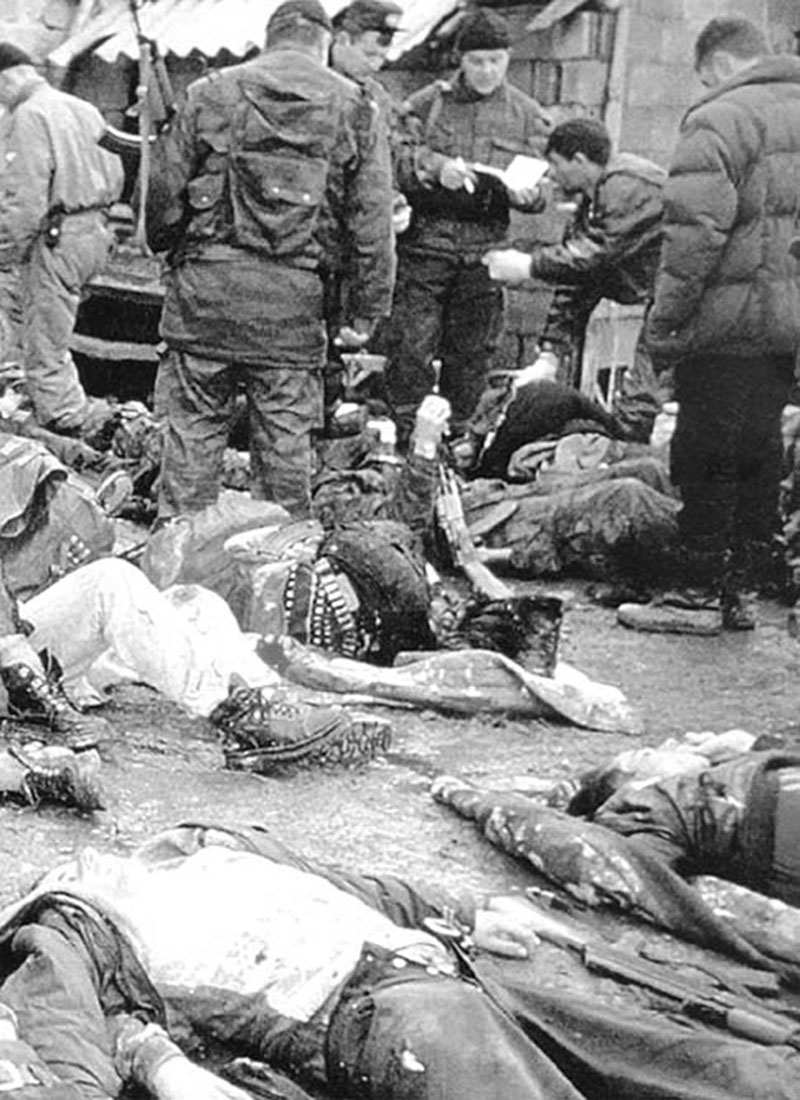 |
| Serbian Violence: Albanian civilians killed by Serbian forces in Kosovo on Jan. 15, 1999. |
133. William Blum, Killing Hope: US Military and CIA Interventions Since World War II, 4.b., London: Zed Books, 1991, p. 264. 
134. William Blum, Killing Hope: US Military and CIA Interventions Since World War II, p. 269. 
135. Russell Watson, John Barry, "Public Enemy No. 1," Newsweek, 9 April 1990, p.8 
136. Ray Wilkinson, "Iraq's Dark Knight," Newsweek, 9 April 1990, p.12. 
137. Ray Wilkinson, "Iraq's Dark Knight," Newsweek, 9 April 1990, p.12. 
138. Turkish Hurrriyet daily, 21 January 1999, Thursday 
139. Ray Wilkinson, "Iraq's Dark Knight," Newsweek, 9 April 1990, p.10 